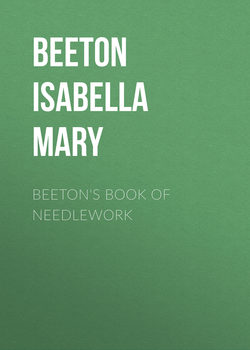Читать книгу Beeton's Book of Needlework - Beeton Isabella Mary - Страница 4
EMBROIDERY
ОглавлениеEMBROIDERY INSTRUCTIONS
The art of embroidering with cotton on linen, muslin, cambric, piqué, &c.c., is very easy to learn by strictly attending to the following instructions.
The size of the thread and needle must correspond to that of the material on which you embroider; the needle must not be too long, and the cotton must be soft. Messrs. Walter Evans and Co.'s embroidery cotton is the best. Skilful embroiderers never work over anything, because when you tack the material on paper or cloth each stitch shows, and if the material is very fine, leaves small holes; but for those that are learning we should advise them to tack the material to be embroidered upon a piece of toile cirée. If you work without this, place the material straight over the forefinger of the left hand; the material must never be held slantways. The three other fingers of the left hand hold the work; the thumb remains free to give the right position to each stitch. The work must always, if possible, lie so that the outline of the pattern is turned towards the person who works. For the sake of greater clearness one part of the following illustrations is given in larger size than nature. Preparing the patterns is one of the most important things in embroidery, for the shape of the patterns is often spoiled merely because they have not been prepared with sufficient care.
ILLUSTRATION 66 shows how to prepare a scallop. Take thicker cotton than that with which you work; never commence with a knot, and do not take a thread longer than sixteen or eighteen inches. The outlines of the scallops are first traced with short straight stitches. In the corners particularly the stitches must be short. The space between the outlines is filled with chain stitches, as can be seen from illustration; they must not be too long, otherwise the embroidery will look coarse. It is in this way that every pattern to be worked in button-hole or satin stitch is to be prepared.
ILLUSTRATION 67 shows the double overcast stitch or button-hole stitch in a straight line. After having traced the outline begin to work from left to right; fasten the cotton with a few stitches, hold it with the thumb of the left hand under the outline, insert the needle downwards above the outline, draw it out under the same above the cotton which you hold in the left hand, and draw it up. Repeat for all the stitches in the same manner; they must be regular and lie close to one another. Great care should be taken that the material on which you embroider is not puckered.
ILLUSTRATION 68 (Overcast Stitch).–The double overcast and the button-hole stitches are worked from left to right, whilst back stitches, knotted and satin stitches are worked from right to left. The stitch is worked in the same way as the double overcast, only the needle must never be drawn out above, but below, the cotton with which you work, and which you keep down with the thumb of the left hand.
ILLUSTRATION 69.–The slanting overcast stitch is worked without tracing the outline, always inserting the needle downwards–that is, from top to bottom. The needle must be inserted in the manner shown in illustration–that is, not straight, but slanting; insert it a little farther than the last stitch, and draw it out close to it. The wrong side of the work must show back stitches. This sort of stitch is used for the fine outlines in patterns or letter.
ILLUSTRATION 70.–This shows the back stitch, the working of which is well known; it is worked in several rows close to each other.
ILLUSTRATIONS 71 & 72 show another kind of back stitch, called point croisé, which is only used on very thin and transparent materials. This stitch forms on the wrong side a sort of darned pattern, which is seen by transparence on the right side, and gives the embroidered pattern a thicker appearance, contrasting with the rest of the work (see the lower leaves of the flower on illustration 110
